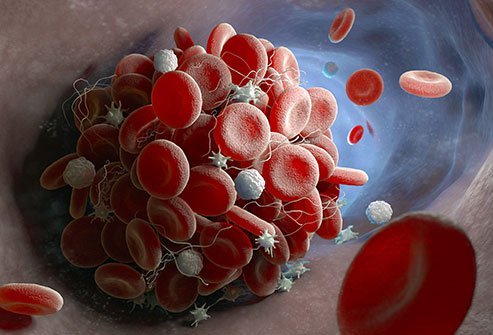What Are the Symptoms of Thrombosis?
What is thrombosis?

Thrombosis occurs when a blood clot obstructs the blood vessels. There are two types of thrombosis:
- Venous thrombosis: It occurs when clots block the blood vessel that carries the blood to the heart.
- Arterial thrombosis: It occurs when clots block the blood vessel that carries the blood from the heart to organs.
Some of the most common venous thromboses include:
- Deep vein thrombosis or a blot clot in the calf veins that can embolize to the lung, causing fatal consequences
- Cerebral venous thrombosis (a blood clot of a cerebral vein in the brain)
- Portal vein thrombosis (a blood clot in the portal vein that supplies the blood to the liver)
- Cavernous sinus thrombosis (a blood clot that blocks a vein that runs through a hollow space underneath the brain and behind the eye sockets)
Some of the most common arterial thrombosis include:
- Myocardial infarction (heart attack)
- Cerebrovascular accident (stroke)
- Claudication or peripheral arterial disease (thrombus in a leg or arm)
Symptoms may vary from person to person. Symptoms of a thrombosis in the extremities may include:
- Pain in one leg (usually the calf or inner thigh)
- Swelling in the leg or arm
- Gangrene (a blackened foot or hand)
- Numbness or weakness on one side of the body
Symptoms of venous thrombosis in the leg include:
- Warmth
- Tenderness
- Redness of the leg or arm
- Worsening leg pain while bending the foot
- Leg cramps, especially at night, which often start in the calf
- Bluish or whitish discoloration of the skin
Symptoms of a thrombosis in the heart or lungs (pulmonary embolism) include:
- Difficulty breathing
- Chest pain that worsens with a deep breath or lying down
- Coughing or coughing up blood
- Rapid or irregular heartbeat
- Lightheadedness
- Decreased blood pressure
- Pain in the back
- Sweating profusely
- Shortness of breath
- Discomfort in the arms, back, neck, or jaw
Symptoms of a thrombosis in the brain include:
- Headaches
- Speech changes (slurring, slowing of speech, or unable to speak)
- Convulsions
- Paralysis
- Dizziness
- Trouble understanding speech
- Loss of consciousness
What are the complications of a thrombosis?
A thrombus or blood clot may cause the following complications:
- Seal off the lumen of the artery that supplies the organ. Depending on the organ affected, it may cause a heart attack, stroke, kidney failure, or gangrene.
- The thrombus may break off and block an organ at a distant site; this is called an embolus. This may cause fatal pulmonary or cerebral symptoms.
Can a thrombosis be prevented?
You can prevent a thrombosis by
- Losing weight.
- Quitting smoking.
- Remaining physically active.
- Exercising your legs during long trips.
- Using special compression stockings.
- Treating varicose veins on time.
- Managing or controlling other health issues, such as diabetes, high blood pressure, and high cholesterol.
- Keep the legs elevated while sitting down or in bed.
- Avoiding birth control pills or hormone therapy unless absolutely necessary.
- Eating a healthy, balanced diet.
- Eating less salt.
- Taking care of the following things while traveling a long distance by a train, car, or plane:
- Avoid sitting for a long time. Get up and move around every 15-30 minutes during long-distance flights. Try simple stretching exercises while being seated.
- Drink plenty of water.
- Avoid drinking excess alcohol because it may lead to dehydration.
- Perform simple leg exercises, such as stretching your legs.
- Wear elastic compression stockings.
- Take occasional short walks when possible.
- Avoid taking sleeping pills because they can lead to immobility.
